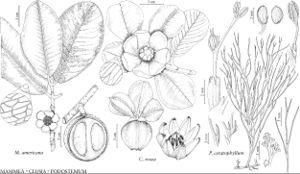Shrubs or trees [lianas], evergreen, usually glabrous. Leaves decussate [whorled], estipulate; petiole usually present; blade margins entire; glandular canals not containing hypericin or pseudohypericin. Inflorescences terminal, dichasial, thyrsoid, or corymbiform or flowers solitary. Pedicels absent or relatively stout. Flowers unisexual [bisexual], actinomorphic, hypogynous; sepals persistent, [2–]4[–14], imbricate or decussate; petals persistent [deciduous], [3–]6(–8)[–14], without ventral scale; [stamens distinct or fasciculate; filaments nearly as wide as anthers; anthers usually dehiscing longitudinally, sometimes locellate, eglandular]; pistils 1; ovary superior, 3–12-locular; placentation axile; ovules 1–6+ per locule, anatropous, bitegmic, tenuinucellate; styles absent [relatively short]; stigmas [3–]6–9(–12). Fruits capsular [berrylike, drupelike], dehiscence septifragal. Seeds arillate, embryo usually green, straight, cotyledons minute [absent], endosperm absent.
Distribution
Fla., Mexico, West Indies, Central America, South America, Asia, Africa, Indian Ocean Islands (Madagascar), pantropical.
Discussion
Genera 15, species ca. 700 (1 in the flora).
